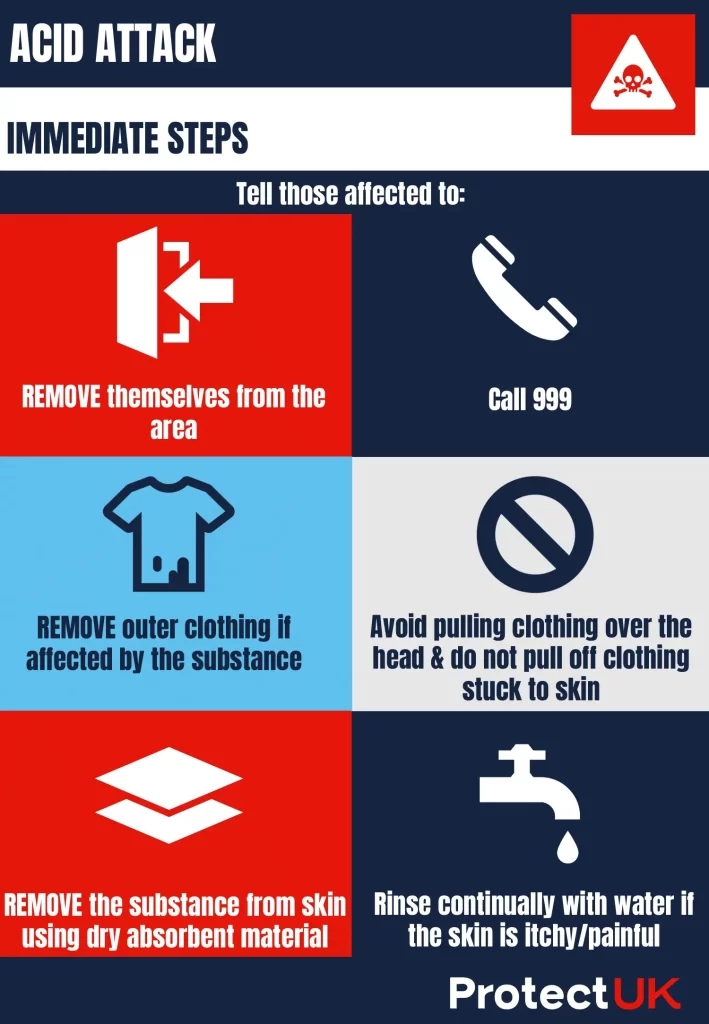
What Happens During an SIA Audit?
By London Security College Is Your Licence Near to Expire? SIA Refresher Training + First
SIA Refresher Training + First Aid– Keep Your Licence Active! Only £199
Acid attacks are brutal and life-altering crimes, increasingly becoming a threat in urban areas across the UK. These attacks can cause severe physical harm and psychological trauma. For security officers, knowing how to respond quickly and effectively is critical in minimising damage and protecting the lives of victims.
The following six-step guide outlines recommended actions for responding to acid attacks based on advice from Protect UK and other safety organisations.
The immediate priority during an acid attack is to remove both yourself and the victim from the dangerous area. Acid can have lingering harmful effects, including fumes affecting the respiratory system or additional splashing that could worsen injuries. Security officers should guide the victim away from the source of the acid, ensuring that both they and others are safe from further exposure.
If the area is crowded, as in public places or events, encourage people to leave calmly but swiftly. Crowd control is essential to prevent panic, which can exacerbate the situation.
Once the area is secure, calling 999 is the next critical step. The faster you notify emergency services, the quicker specialised help can arrive. Provide the operator with all necessary details, including:
This information helps emergency services dispatch the right resources, such as paramedics with knowledge of chemical injuries or police to control the crime scene.
After ensuring that emergency services have been contacted, the next step is to help the victim remove any outer clothing contaminated by the acid. These layers of clothing often contain the most concentrated amount of acid, and removing them can significantly reduce the severity of the injuries.
It is vital to avoid pulling clothing over the head to prevent spreading acid to sensitive areas like the face, neck, and eyes. Instead, cut the clothing away or slide it off the body without pulling it over the head.
Before rinsing the affected area with water, it is important to blot the acid from the skin using a dry, absorbent material like a towel, cloth, or paper. This can help remove the chemical from the surface and reduce further skin penetration.

Once the acid has been blotted away, rinse the affected area continuously with cool water. The water should flow over the area for at least 20 minutes. This step is crucial in diluting the acid and neutralising its effects.
In addition to the six essential steps, security officers should also consider these points:
Acid attacks are one of the most harrowing forms of violence, but proper training and quick action can significantly mitigate the damage. Security officers have a vital role in ensuring public safety, and knowing how to respond to these incidents can make the difference between life and death.
For more detailed guidance and resources on handling chemical attacks, visit Protect UK.
By following these steps, security officers can help reduce the impact of acid attacks, ensuring the safety of the public and improving the chances of a full recovery for the victim.

By London Security College Is Your Licence Near to Expire? SIA Refresher Training + First

By London Security College Is Your Licence Near to Expire? SIA Refresher Training + First

By London Security College Is Your Licence Near to Expire? SIA Refresher Training + First

By London Security College Is Your Licence Near to Expire? SIA Refresher Training + First
London| Birmingham| Manchester | Leeds | Glasgow | Sheffield
London Security College is the leading supplier of SIA Licence courses in London. We excel in SIA Courses such as SIA Door Supervisor Course, SIA Top Up Training, SIA CCTV Surveillance Course, First Aid Courses, Traffic Marshal Banksman Course Online, and Forklift Training Course.
“It is impossible for a man to learn what he thinks he already knows”
London Security College
International House,
24 Holborn Viaduct,
London, EC1A 2BN
020 8050 4108
Copyright © LONDON SECURITY COLLEGE is a training and hiring platform

Fill in the form below